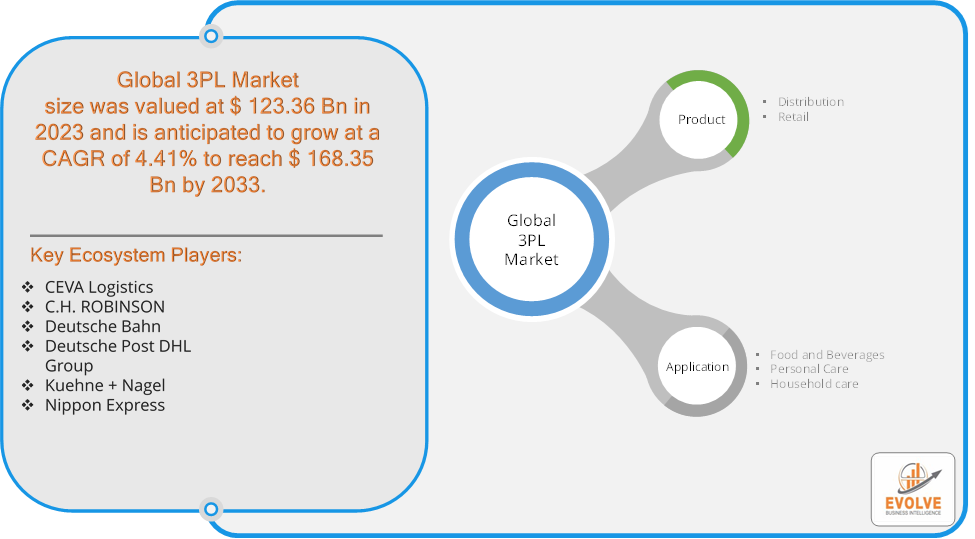3PL in FMCG Market Expands: 4.41% CAGR Predicted

Evolve Business Intelligence has published a research report on the Global 3PL Market, 2023–2033. The global 3PL market is projected to exhibit a CAGR of around 4.41%during the forecast period of 2023 to 2033.
Evolve Business Intelligence has recognized the following companies as the key players in the global 3PL Market: CEVA Logistics, H. ROBINSON, Deutsche Bahn, Deutsche Post DHL Group, Kuehne + Nagel, Nippon Express.
 Market Highlights
Market Highlights
The Global 3PL market is projected to be valued at USD 168.35 Billion by 2033, recording a CAGR of around 4.41% during the forecast period. FMCGs or “Fast Moving Consumer Goods” are the largest group of consumer goods, covering a wide range of different product categories such as health and beauty, home care, personal care, food and drink, and many other necessities. 3PL or third-party logistics providers are a good option for start-up companies in the FMCG markets with large volumes. 3PLs are the third-party companies that offer supply chain management and the services required to secure their operations. The services provided by 3PLs are transport, packing, storage, consolidation, and other services that are needed to increase efficiency. For companies with high demand but low capital, 3PLs provide a good option for them. These companies can be small companies or large companies.
The 3PL in the FMCG market was severely affected by the COVID-19 pandemic. With the threat of COVID-19, many countries were left with no choice but to halt trading with one another in a bid to save themselves. This has caused disruptions in the supply chain and reduced supplies of goods that are needed. In addition, many countries have imposed a nationwide shutdown for non-essential shopping of all retail outlets. This has caused a setback for the FMCG logistics industry as transportation of these products is not needed anymore. The food and beverage industry has also been severely impacted by the global pandemic. Offline dining venues such as restaurants and cafes have been shut down due to the pandemic, while online orders for food also decreased.
Segmental Analysis
The global 3PL market has been segmented based on Product Type, Capacity
Based on the Product Type, the 3PL in the FMCGs market is segmented based on Distribution and Retail. The Distribution segment is anticipated to account for the large market share. The Distribution segment is dominating due to the large companies in this sector having global awareness, partnerships with key clients, high cost-effectiveness, and flexibility. The large players in this segment are DHL, C&S Logistics, UPS, and others. They’re rapidly expanding into the retail sector by providing services such as drop-shipping, home-delivery, and shipping of different types of products.
Based on Application, the global 3PL in the FMCG market has been divided into Food and Beverages, Personal Care, and Household Care. The Food and Beverage segment is expected to hold the largest market share. The food and beverage segment accounts for the majority of applications for the FMCG logistics market due to the growth in the sales of packaged food products and staple food products. The increase in hectic lifestyles has caused a demand for ready-made food products as people are having less time to cook at home. Furthermore, the population growth and rise in the number of retail stores will increase the demand for 3PLs in the market.
Regional Analysis
The 3PL market is divided into five regions: North America, Europe, Asia-Pacific, South America, and the Middle East, &Africa. North America dominates the 3PL in the FMCG market, with a diverse coastline being one of its attributes. In addition, it also has many cruising destinations. The U.S. ranks at the top in this region, as there are many important logistical and supply chain locations situated there. The resurgence of the logistics industry in the U.S. can be seen after the strict lockdown due to the COVID-19 pandemic subsided. The Asia Pacific region is expected to experience a very strong CAGR over the forecast period. The sector has been growing steadily in popularity mainly because both the middle-income class and production costs are declining. The projection of rapid growth in the higher-end services sector in China and emerging markets suggests a shift towards contract logistics companies with the latest high-tech equipment. The current demand for items such as more expensive consumer goods and perishable food is predicted to skyrocket, which will require new innovative logistical solutions.


